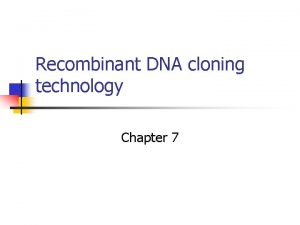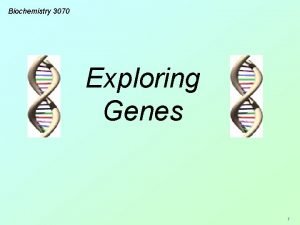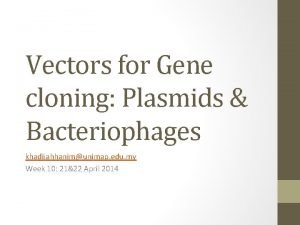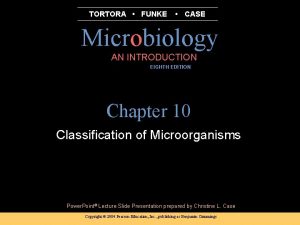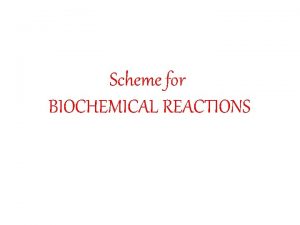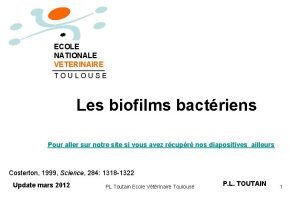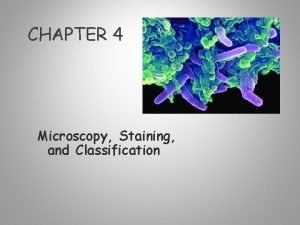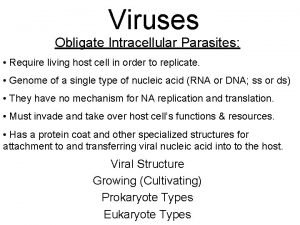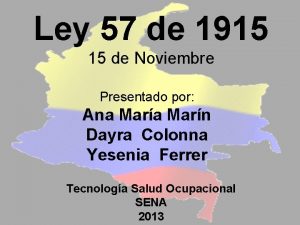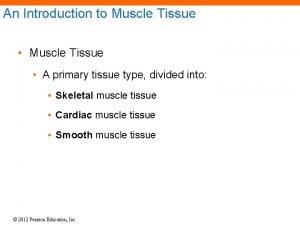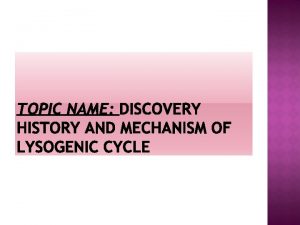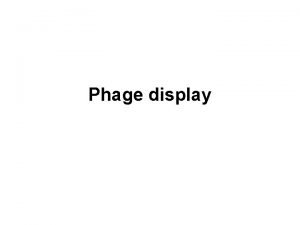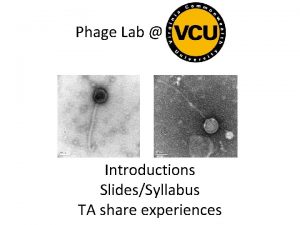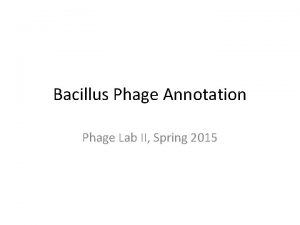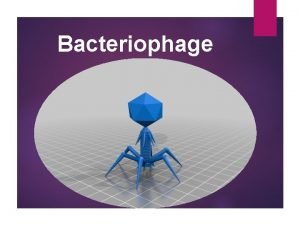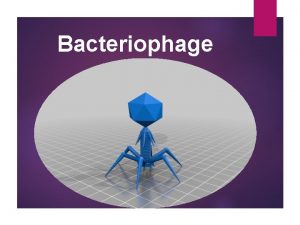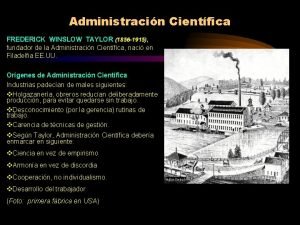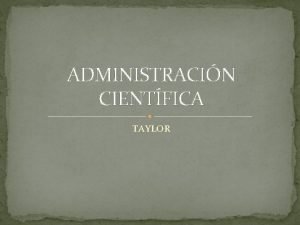Phage therapy History Frederick Twort 1915 Flix dHrelle



























- Slides: 27

Phage therapy: History Frederick Twort 1915 Félix d'Hérelle 1917 George Eliava

Phages, short for bacteriophages, are bacteria-specific viruses that have been used as a treatment against pathogens such as Shigella dysenteriae as early as 1919. With an estimated 1031 -1032 phages in the world at any given time, they make up the most abundant biological entity on Earth and play a crucial role in regulating bacterial populations; phages are responsible for the death of approximately 20%-40% of all marine surface bacteria every 24 h.

Le prime evidenze sull’esistenza di fagi La prima evidenza dell’esistenza di un agente di tipo virale con proprietà antibatterica risale al 1896 con M. E. Hankin che trova nel fiume Gange un elemento termosensibile, in grado di passare il filtro di porcellana e capace di ridurre significativamente il titolo di Vibrio cholerae in laboratorio. Adhya S and C. Merril. 2006. The road to phage therapy. Nature 443: 754755


Prime informazioni sull’uso clinico dei fagi iniziano con d’Herelle negli anni 20 • d’Herelle’s first clinical experiences in 1920’s Per il trattamento della dissenteria… d'Herelle F. (1917). Sur un microbe invisible antagoniste des bacilles dysentériques. Acad. Sci. Ser. D 165: 373 Per il trattamento della peste… - d’Herelle F. (1925) Essai de traitement de la peste bubonique par le bactériophage. La Presse Med. 33: 1393 -94. George Eliava starts the microbiology institute in Tbilisi (1923), has been working at the Pasteur Institute of Paris with D’Herelle (191821 and 1926 -27)) and d‘Hérelle is invited by Stalin to the Eliava Institute (1936). d'Hérelle worked at the Tbilisi Institute and even dedicated one of his books, published in Tbilisi in 1935, to Comrade Stalin. He had already started to build a cottage on the grounds of the Institute. But just then, his friend Eliava fell in love with the Georgian woman with whom the head of the secret police also happened to be in love. Eliava's fate was sealed. He was executed and denounced as an enemy of the people. d'Hérelle ran for his life and never returned to Tbilisi.

It was also d’Herelle who conceived of the idea to use phages therapeutically and is responsible for the first documented clinical use of phage in 1919 at the Hôpital des Enfants-Malades in Paris where phages were successfully used to treat 4 pediatric cases of bacterial dysentery[1]. Despite several successful trials, d’Herelle’s early experiments were notorious for being poorly controlled and his research was vigorously disputed by the scientific community[3]. Nevertheless, d’Herelle continued to pioneer phage therapy with the treatment of dysentery, cholera, and the bubonic plague in the early 20 th century with a series of phage therapy centers and commercial phage production plants throughout Europe and India[34]. One 1931 trial of phage therapy as a treatment for cholera in the Punjab region of India involved a cohort of 118 control subjects and 73 experimental subjects who received phage treatment; d’Herelle observed a 90% reduction in mortality with 74 lethal outcomes in the control group and only 5 in the experimental group[1].

La Phagetherapy comincia prima della scoperta degli antibiotici ma viene abbandonata con l’avvento degli antibiotici Commercialization of phages in France and USA in 1930’s L’Oréal: Bacté-intesti-phage, Bacté-pyo-phage, Bacté-staphylo-phage Eli Lilly: Colo-lysate, Entero-lysate, Staphylo-lysate Phage therapy was abandoned in the West, because of lack of understanding of the high specificity and mode of action of phages exaggerated claims of effectiveness: urticaria, herpes, eczema the rise of broad-spectrum antibiotics but phage therapy research continued in Eastern Europe. . .

Perché la phagetherapy può essere una nuova strategia? - Il problema della resistenza agli antibiotici sta aumentando -Il numero di nuovi antibiotici in sperimentazione è limitato - Molte infezioni croniche sono dovute alla formazione di biofilm contro I quali gli antibiotici hanno effetto limitato in CF-patients: Pseudomonas aeruginosa Nelle otiti croniche Haemophilus influenzae, Alloiococcus otitidis? Nelle infezioni urinarie uropathogenic Escherichia coli Nelle vaginosi : Gardnerella vaginalis, Atopobium vaginae Nelle ustioni Pseudomonas aeruginosa, Staphylococcus aureus nelle infezioni di cateteri , valvole , protesi : Staphylococcus spp.

Quali sono i potenziali vantaggi della phagetherapy ? - Nessun effetto sul microbioma commensale - Nessun effetto di resistenza crociata - Possibilità di creare un cocktail di fagi che può essere facilmente e personalizzato sul paziente /infezione - I batteri MDR (Multi Drug Resistant) possono essere trattati

Quali sono i possibili usi della phagetherapy? 1. Il classico : l’uso di un cocktail di fagi litici virulenti come antibatterici Merril et al. 2003. The prospect for bacteriophage therapy in Western medicine. Nature Reviews/Drug Discovery 2: 489 -497. 2. l’uso di prodotti derivati da fagi quali T 4 -lisozima, depolimerasi della capsula, lisine etc Loeffler et al. 2001. (Rapid killing of Streptococcus pneumoniae with a bacteriophage cell wall hydrolase. Science 294: 2170 -2172. 3. Fagi lisogenici per il rlascio in situ di geni particolari quali : --> in situ delivery to bacterial cells of * killing genes (doc) * antisense RNA to block translation Westwater et al. 2003. Use of a genetically engineered phage to deliver antimicrobial agents to bacteria: an alternative therapy for treatment of bacterial infections. Antimicrob. Agents Chemother. 47: 1301 -1307. 4. Utilizzo dei fagi come probiotici con effetti immunomodulatori Phages inhibit human T-cell activation and proliferation Phages diminish cellular infiltration into allogeneic skin allografts Gorski et al. 2006. Bacteriophages and transplantation tolerance. Transplant. Proc. 38: 31 -333.

Vi sono rischi nell’utilizzazione di fagi nella terapia? Phages are safe by definition: viruses which infect bacteria only 1. Bacteriophages infect specifically bacteria since they need to recognize bacterial cell wall structures: peptidoglycane, LPS. 2. Bacteriophages that were manipulated genetically to infect mammalian cells were not able to multiply inside the mammalian cells after infection. 3. No bacteriophage genes can be found in the human genome, whereas retro-viruses have left hundreds of genes integrated into the human genome. In summary, bacteriophages have no tropism towards mammalian cells and cannot multiply in them

Ma viene gia utilizzata la phagetherapy sull’uomo? During the long history of using bacteriophages as therapeutic agents bacteriophages have been administered to thousands of humans (i) orally, in tablet or liquid formulations (log 5 to log 11 bacteriophages/dose), (ii) rectally, (iii) locally: skin, eye, ear, nasal mucosa, burn wounds, rinses and creams (iv) as aerosols or intrapleural injections, and (v) intravenously, albeit to a lesser extent than the first four methods. Only one group, from the Hirszfeld Insitute, Wroclaw, Poland, renown for its clinical application of bacteriophages reported a few minor side effects (e. g. nausea, fever). These effects may have been due to the liberation of endotoxins from lysed bacteria, a phenomenon that can also be observed when antibiotics are used and therefore cannot be considered as specifically bacteriophage related.

Perché la phagetherapy può essere un’ alternativa? • Phage therapy is one of the viable alternatives to antibiotics • Phages are currently being used therapeutically to treat bacterial infections that do not respond to conventional antibiotics. • Phage therapy has many applications in human medicine as well as dentistry, veterinary science and agriculture. • An important benefit of phage therapy is that bacteriophages can be much more specific than more common drugs and thus harmless to not only the host organism (human, animal or plant). • Because the phages replicate in the organism itself, a single, small dose is sometimes sufficient.

Phagetherapy come vaccino? ? Vaccination" study in Tbilisi, Georgia (1965) 30. 769 children aging 6 months to 7 years old. 17. 044 children ingested bacteriophages against Shigella dysenteriae. 13. 725 children, living at the opposite side of the streets, served as a control group. Babalova et al. 1968. Preventive value of dried dysentery bacteriophage. Zh. Mikrobiol. Epidemiol. Immunobiol. 2: 143 -145.

Characterization of the PAK-P 1 bacteriophage. A, Electron microscopic analysis of the PAK-P 1 bacteriophage (scale bar, 100 nm).

Effect of bacteriophage treatment on deadly infection in mice. . A, Survival curves of infected animals treated with phosphate- buffered saline (PBS) or bacteriophages at indicated bacteriophage-to bacterium ratios. The amount of bacteria required to induce a deadly lung infection in Balb/c mice by way of intranasal instillation (was set to 1 × 107 bacteria, because we found that 100% of mice survived challenge by 5 × 107 bacteria for up to 4 days and that a dose of 1. 5 × 107 bacteria was 100% lethal within 24 h. B, Example of time-course images of mice infected with bioluminescent Pseudomonas aeruginosa and treated with PBS (left) or treated with the PAK-P 1 bacteriophage at a bacteriophage-to-bacterium ratio of 10: 1 (right). . Debarbieux L et al. J Infect Dis. 2010; 201: 1096 -1104 Necessario un rapporto di 10/1 a fago/batterio per avere un effetto sulla sopravvivenza

Reduction of inflammation by bacteriophage treatment. Cytokine levels were measured in bronchoalveolar lavages of mice (n = 4) 24 h after instillation of phosphate-buffered saline (PBS) (black bars), PBS and PAK-P 1 bacteriophage (white bars), bacteria with PBS 2 h later (hatched bars), or bacteria with PAK-P 1 bacteriophage 2 hlater(gray bars). Bars show the mean, and error bars show the standard error. IL 6, interleukin 6; TNF-α, tumor necrosis factor α. Debarbieux L et al. J Infect Dis. 2010; 201: 1096 -1104 © 2010 by the Infectious Diseases Society of America

Time-course images of bacteriophage treatment A, Survival curves of infected mice treated with phosphate-buffered saline (PBS) (diamonds) or with the PAK-P 1 bacteriophage at a phage-to-bacterium ratio of 10: 1 at 2 h (squares), 4 h (triangles), or 6 h(circles) after the infection was initiated. B, Images corresponding to the early time points of the experiment presented in panel A. p/s/cm 2/sr, photons/s/ cm 2/steradian.

Efficacy of bacteriophage pretreatment 24 h before infection. Shown is the time course of light emitted (in photons/s) from the chest area of mice pretreated with phosphatebuffered saline (PBS) (white bars) or with PAK-P 1 bacteriophage (black bars) 24 h before infection with Pseudomonas aeruginosa (n = 4 for each group). Bars show the mean, and error bars show the standard error. Debarbieux L et al. J Infect Dis. 2010; 201: 1096 -1104 ica

I fagi possono ridurre biofilm formatisi su superfici abiotiche Effetto del trattamento con il fago M 4 della superficie di un catetere infettata con Pseudomonas aeruginosa Sia il pretrattamento con il fago che il post trattamento provocano un a riduzione significativa dell’assorbimento del batterio

Immagine al microscopio a scansione di un biofilm di P. aeruginosa formatosi sulla superficie di un catetere di silicone dopo 24 h Il pretrattamento con il fago M 4 impedisce la formazione del biofilm sulla superficie del catetere infettata x 24 ore


Phagetherapy negli animali Currently there are no phage therapy products approved for human use in the EU or United States. However, in the food industry, there are several commercial phage preparations used for biocontrol of bacterial pathogens that are approved by the FDA under the classification of “generally considered as safe. ” These preparations are used against Salmonella spp. , Listeria monocytogenes, MRSA, E. coli O 157: H 7, Mycobacterium tuberculosis, Campylobacter spp. , and Pseudomonas syringae, among others

Among the most promising of advances in phage therapy is the isolation of phage-encoded lytic enzymes, which are functionally similar to the eukaryotic enzyme lysozyme. Genes for these enzymes are expressed by the bacterial host during the lytic cycle and assist the phage by hydrolyzing the cell wall to release viral progeny. The discovery and analysis of these proteins opens the possibility for the development of novel phage-based pharmaceuticals.

Oline ed endolisine : antibatterici promettenti contro i Gram+ Phage lysins alone are capable of bacterial cell lysis, whereas holins are not; therefore lysins have received a lot of attention as potential antimicrobial agents. These proteins are fast acting, potent, and inactive against eukaryotic cells. Lysins have successfully saved mice from bacteremia caused by multidrugresistant A. baumannii, Streptococcus pneumoniae, and MRSA, among others. A combination of phage lysins and antibiotics has been shown to be much more effective than antibiotics alone in eliminating C. difficile colonization in both an in vitro and an ex vivo colon model in the presence of intestinal contents.


Among the most promising of advances in phage therapy is the isolation of phageencoded lytic enzymes, which are functionally similar to the eukaryotic enzyme lysozyme. Genes for these enzymes are expressed by the bacterial host during the lytic cycle and assist the phage by hydrolyzing the cell wall to release viral progeny. The discovery and analysis of these proteins opens the possibility for the development of novel phage-based pharmaceuticals. Two major protein classes are employed by the majority of phage species during the lysis of the bacterial host. One of which is the transmembrane protein holin and the other is a peptidoglycan cell wall hydrolase called endolysin (lysin). These two proteins work together in triggering the lysis of the bacterial cell. The holin protein acts as a molecular “clock” in the lytic cycle. During the process of viral assembly within the cytoplasm, holin molecules accrue in the cell membrane. At the end of the lytic cycle the holin proteins trigger an opening on the cytoplasmic side of the cell membrane, allowing the lysin proteins to access and hydrolyze the cell wall. Although both of these enzymes are present across the majority of phage species, there is huge structural and biochemical variability and therefore little sequence conservation among species. Each phage can encode for several unique lysin and holin enzymes, some of which are highly specific but others can exhibit broad-spectrum activity between strains and even between species as in the case of recently discovered lysin ABgp 46 has the ability to lyse several gram-negative and multidrug-resistant pathogens, including A. baumannii, P. aeruginosa, and Salmonella typhimurium.
 Frederick twort
Frederick twort Frederick taylor (1856-1915)
Frederick taylor (1856-1915) Crine suffix
Crine suffix Yeast artificial chromosome
Yeast artificial chromosome Desktop dna synthesizer
Desktop dna synthesizer Function of plasmid
Function of plasmid Phage typing
Phage typing Solid
Solid Phage
Phage Schaeffer fulton stain
Schaeffer fulton stain Phage typing
Phage typing T4 bacteriophage
T4 bacteriophage Phage virus
Phage virus Tom thomson, opulent october, winter, 1915
Tom thomson, opulent october, winter, 1915 Metamorphosis 1915
Metamorphosis 1915 Ley 57
Ley 57 Franz kafka, “the metamorphosis” (1915)
Franz kafka, “the metamorphosis” (1915) Kommunista címer
Kommunista címer Acchiapparella
Acchiapparella Kafkaesque meaning
Kafkaesque meaning 1915 folkmord
1915 folkmord A&p flix activity: generation of an action potential
A&p flix activity: generation of an action potential M flix
M flix Relaxation and contraction of muscles
Relaxation and contraction of muscles Generation of action potential
Generation of action potential Nlt flix
Nlt flix The slide flix
The slide flix La retama chicote
La retama chicote



